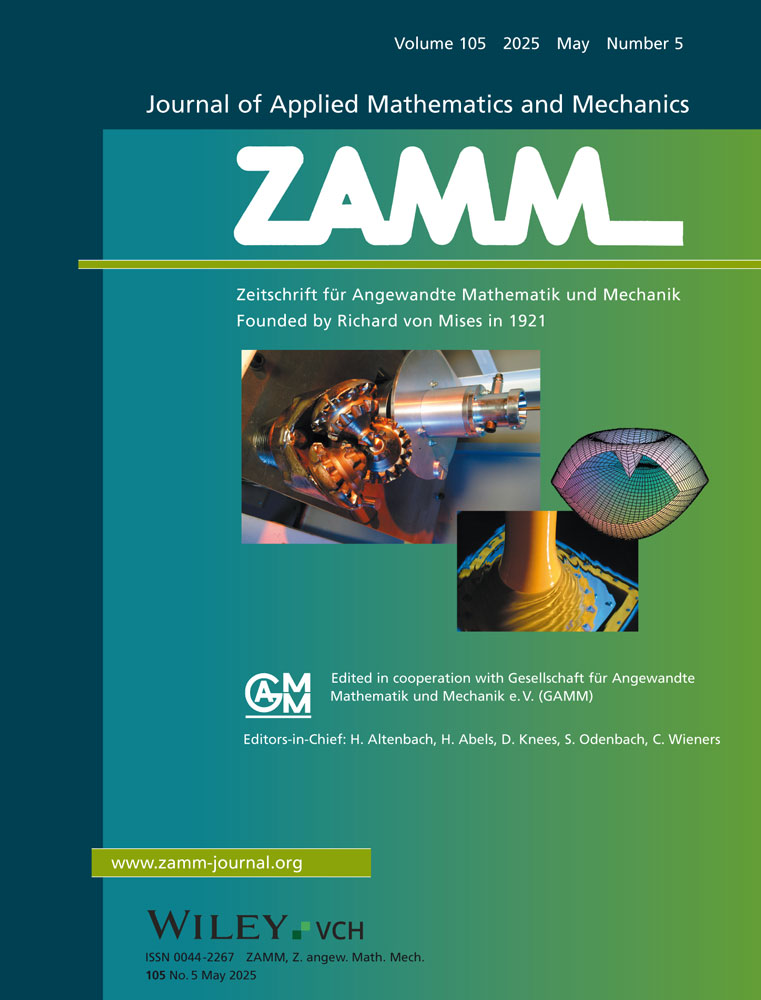1 INTRODUCTION
The article [1] presented a model of bending of the Timoshenko and Euler–Bernoulli nano-rod incorporating the Steigmann–Ogden surface elasticity [2] in comparison with the Gurtin–Murdoch surface elasticity [3]. The results of modeling were illustrated by the examples of buckling of a simply supported nano-rod and a nano-cantilever under its own weight.
In this paper, some refinement of the model formulation is made to take into account surface tension on the lateral surface of a nano-rod. This refinement is specific to the bending of nano-rods, but not to nano-plates, where the effect of surface tension at the ends of the plate is not considered.
2 REFINEMENT OF THE STRAIN ENERGY AND GOVERNING EQUATIONS
In Section 2.2 [
1], the potential energy on the lateral surface of the nano-rod is derived from the surface elasticity [
2, 3]. In particular on the lateral surface
, the term
was omitted in the group of gradient terms with the coefficient
in Equation (16). After integrating over the thickness of the lateral surface
, a coefficient appears, expressed by the line integral over the perimeter
of a cross section
, where
is the projection of the normal onto the
-axis. In particular, for a rectangular cross-section
. With this term, the total energy of the Timoshenko nano-rod has the form
(17) and the total energy of the Euler–Bernoulli nano-rod correspondently
(18)
In Section 2.3 [
1], the governing equations are derived from the Hamilton principle and the additional gradient term will also affect these equations. Omitting the intermediate expressions, I will indicate the final form of the governing equation for the Timoshenko nano-rod (the change concerns only the equation for the bending moment)
(28) and the new form of the bending equation
(30)
Correspondently in the case of the Euler–Bernoulli nano-rod, the governing equation and the bending equation have the form
(33)
(35) It is clearly seen from the bending Equation (
35) that the additional gradient term changes the coefficient at
:
, that is, one and a half times more than without
.
3 REFINED NUMERICAL RESULTS AND CONCLUSIONS
In Table 1 (united Tab. 2 and 3 of Section 4.3 [1]), the refined results of calculation of the inverse maximal eigenvalue (proportional to the Euler critical load) are presented. Compared with the previous results, an increase in the size effect of approximately to 18% and to 6%−13% between the Steigmann–Ogden and Gurtin–Murdoch models is seen.
TABLE 1.
Inverse maximal eigenvalue of buckling of a nano-rod in dependence in the thickness.
| Model |
Ag |
Simple supported nano-rod |
Nano-cantilever |
| 2 nm |
10 nm |
100 nm |
2 nm |
10 nm |
100 nm |
| Euler–Bernoulli |
| Steigmann–Ogden |
|
111.38 |
35.26 |
20.27 |
118.22 |
32.33 |
10.66 |
| Gurtin–Murdoch |
|
97.99 |
35.18 |
20.27 |
103.72 |
32.22 |
10.66 |
| Steigmann–Ogden |
|
67.12 |
37.17 |
20.90 |
69.88 |
34.80 |
11.68 |
| Gurtin–Murdoch |
|
63.41 |
36.43 |
20.89 |
65.73 |
33.84 |
11.66 |
| Timoshenko |
| Steigmann–Ogden |
|
113.46 |
34.58 |
19.66 |
120.68 |
32.06 |
10.56 |
| Gurtin–Murdoch |
|
99.41 |
31.49 |
19.66 |
105.52 |
31.96 |
10.56 |
| Steigmann–Ogden |
|
66.89 |
36.38 |
20.27 |
70.17 |
34.48 |
11.56 |
| Gurtin–Murdoch |
|
62.96 |
35.61 |
20.27 |
65.83 |
33.52 |
11.56 |




